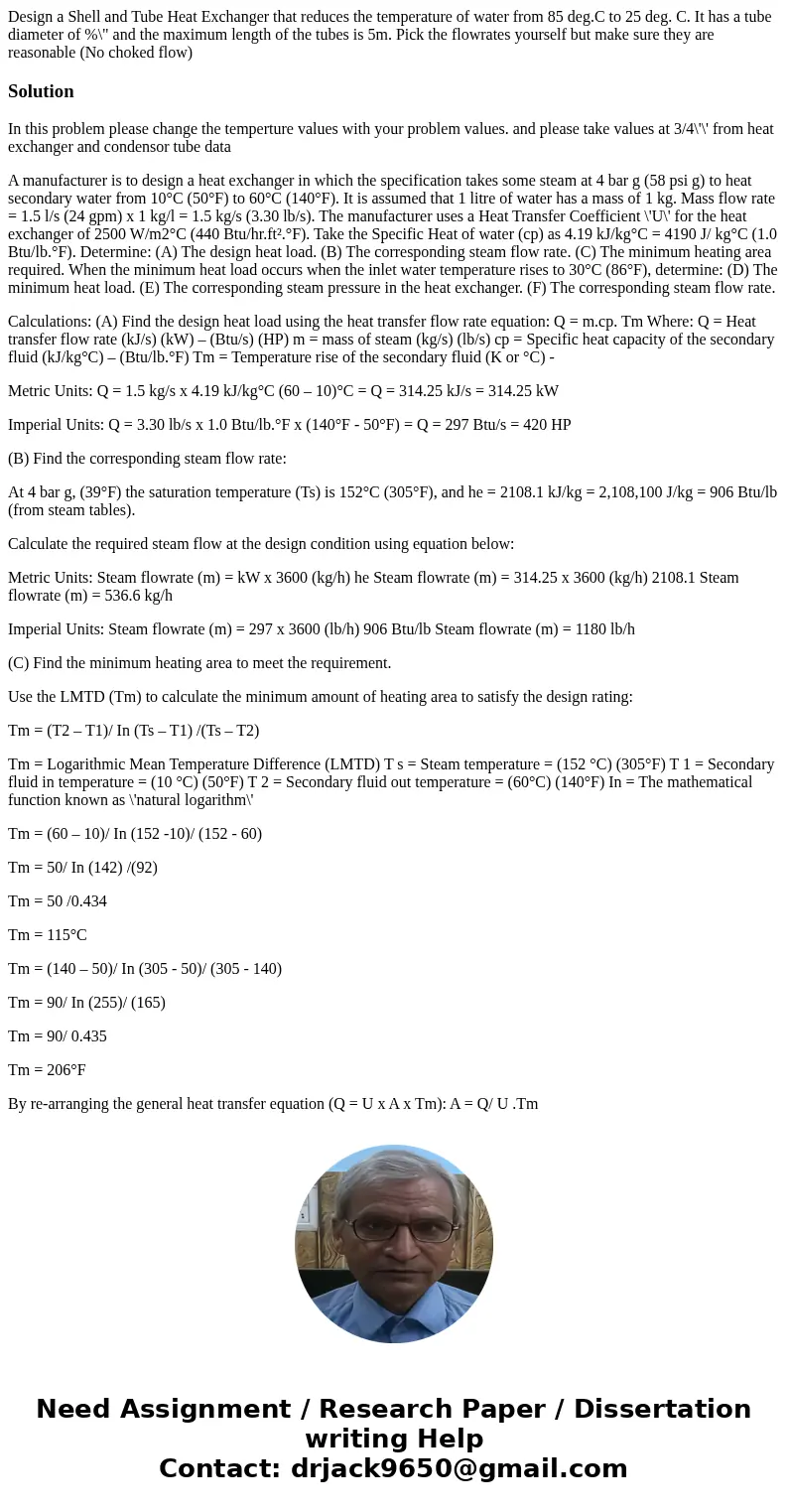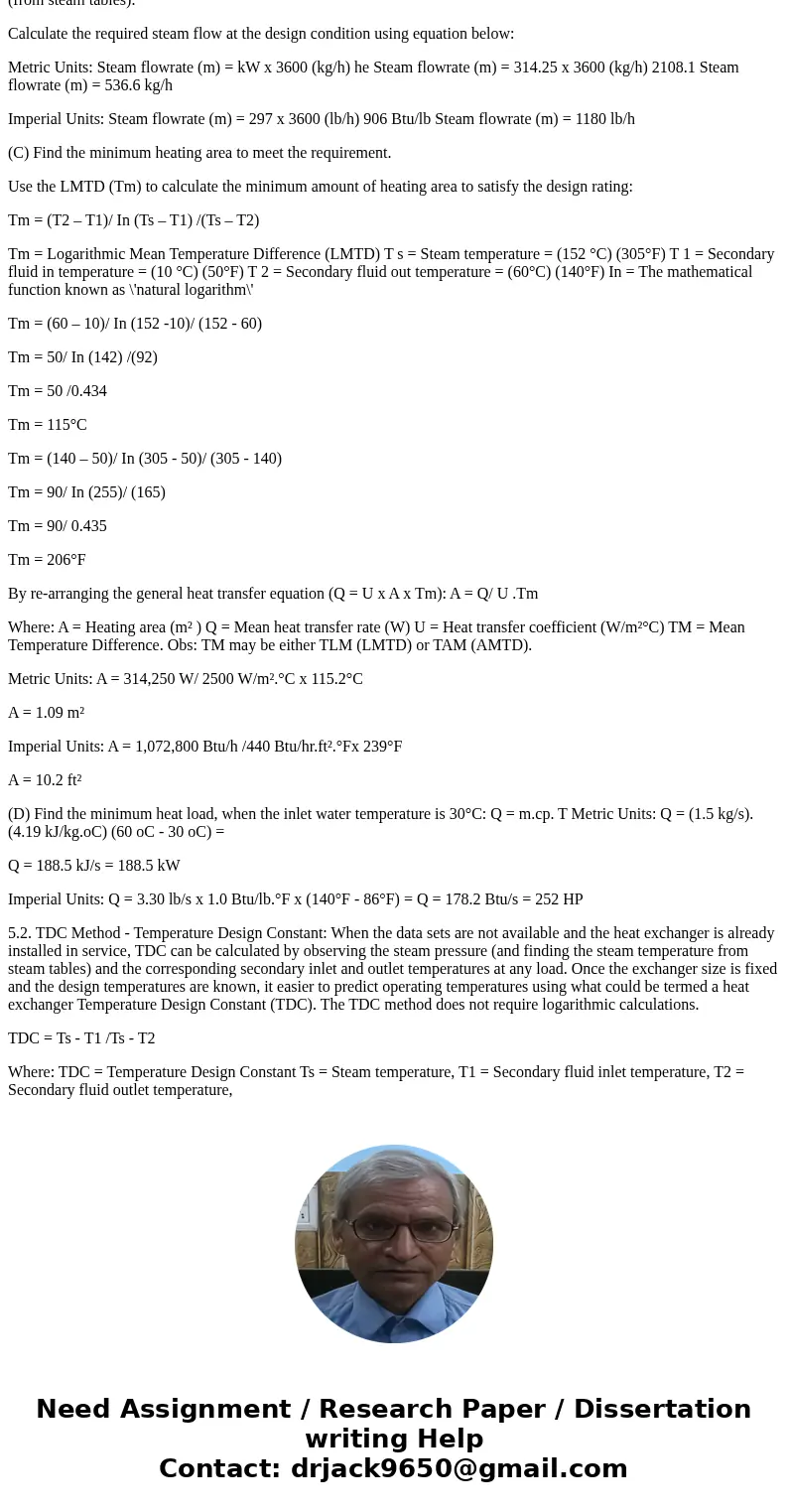Design a Shell and Tube Heat Exchanger that reduces the temp
Solution
In this problem please change the temperture values with your problem values. and please take values at 3/4\'\' from heat exchanger and condensor tube data
A manufacturer is to design a heat exchanger in which the specification takes some steam at 4 bar g (58 psi g) to heat secondary water from 10°C (50°F) to 60°C (140°F). It is assumed that 1 litre of water has a mass of 1 kg. Mass flow rate = 1.5 l/s (24 gpm) x 1 kg/l = 1.5 kg/s (3.30 lb/s). The manufacturer uses a Heat Transfer Coefficient \'U\' for the heat exchanger of 2500 W/m2°C (440 Btu/hr.ft².°F). Take the Specific Heat of water (cp) as 4.19 kJ/kg°C = 4190 J/ kg°C (1.0 Btu/lb.°F). Determine: (A) The design heat load. (B) The corresponding steam flow rate. (C) The minimum heating area required. When the minimum heat load occurs when the inlet water temperature rises to 30°C (86°F), determine: (D) The minimum heat load. (E) The corresponding steam pressure in the heat exchanger. (F) The corresponding steam flow rate.
Calculations: (A) Find the design heat load using the heat transfer flow rate equation: Q = m.cp. Tm Where: Q = Heat transfer flow rate (kJ/s) (kW) – (Btu/s) (HP) m = mass of steam (kg/s) (lb/s) cp = Specific heat capacity of the secondary fluid (kJ/kg°C) – (Btu/lb.°F) Tm = Temperature rise of the secondary fluid (K or °C) -
Metric Units: Q = 1.5 kg/s x 4.19 kJ/kg°C (60 – 10)°C = Q = 314.25 kJ/s = 314.25 kW
Imperial Units: Q = 3.30 lb/s x 1.0 Btu/lb.°F x (140°F - 50°F) = Q = 297 Btu/s = 420 HP
(B) Find the corresponding steam flow rate:
At 4 bar g, (39°F) the saturation temperature (Ts) is 152°C (305°F), and he = 2108.1 kJ/kg = 2,108,100 J/kg = 906 Btu/lb (from steam tables).
Calculate the required steam flow at the design condition using equation below:
Metric Units: Steam flowrate (m) = kW x 3600 (kg/h) he Steam flowrate (m) = 314.25 x 3600 (kg/h) 2108.1 Steam flowrate (m) = 536.6 kg/h
Imperial Units: Steam flowrate (m) = 297 x 3600 (lb/h) 906 Btu/lb Steam flowrate (m) = 1180 lb/h
(C) Find the minimum heating area to meet the requirement.
Use the LMTD (Tm) to calculate the minimum amount of heating area to satisfy the design rating:
Tm = (T2 – T1)/ In (Ts – T1) /(Ts – T2)
Tm = Logarithmic Mean Temperature Difference (LMTD) T s = Steam temperature = (152 °C) (305°F) T 1 = Secondary fluid in temperature = (10 °C) (50°F) T 2 = Secondary fluid out temperature = (60°C) (140°F) In = The mathematical function known as \'natural logarithm\'
Tm = (60 – 10)/ In (152 -10)/ (152 - 60)
Tm = 50/ In (142) /(92)
Tm = 50 /0.434
Tm = 115°C
Tm = (140 – 50)/ In (305 - 50)/ (305 - 140)
Tm = 90/ In (255)/ (165)
Tm = 90/ 0.435
Tm = 206°F
By re-arranging the general heat transfer equation (Q = U x A x Tm): A = Q/ U .Tm
Where: A = Heating area (m² ) Q = Mean heat transfer rate (W) U = Heat transfer coefficient (W/m²°C) TM = Mean Temperature Difference. Obs: TM may be either TLM (LMTD) or TAM (AMTD).
Metric Units: A = 314,250 W/ 2500 W/m².°C x 115.2°C
A = 1.09 m²
Imperial Units: A = 1,072,800 Btu/h /440 Btu/hr.ft².°Fx 239°F
A = 10.2 ft²
(D) Find the minimum heat load, when the inlet water temperature is 30°C: Q = m.cp. T Metric Units: Q = (1.5 kg/s).(4.19 kJ/kg.oC) (60 oC - 30 oC) =
Q = 188.5 kJ/s = 188.5 kW
Imperial Units: Q = 3.30 lb/s x 1.0 Btu/lb.°F x (140°F - 86°F) = Q = 178.2 Btu/s = 252 HP
5.2. TDC Method - Temperature Design Constant: When the data sets are not available and the heat exchanger is already installed in service, TDC can be calculated by observing the steam pressure (and finding the steam temperature from steam tables) and the corresponding secondary inlet and outlet temperatures at any load. Once the exchanger size is fixed and the design temperatures are known, it easier to predict operating temperatures using what could be termed a heat exchanger Temperature Design Constant (TDC). The TDC method does not require logarithmic calculations.
TDC = Ts - T1 /Ts - T2
Where: TDC = Temperature Design Constant Ts = Steam temperature, T1 = Secondary fluid inlet temperature, T2 = Secondary fluid outlet temperature,


 Homework Sourse
Homework Sourse